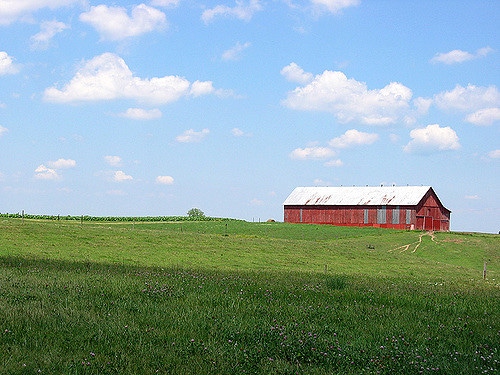Pritchard’s methods of farming will not feed the masses but farms like Fair Oaks will do just that.

In early May, I had the privilege of receiving a tour of Fair Oaks Farm, including its Dairy Adventure and Pig Adventure. I had read and heard much about this very unique farm but had never had a reason to fly to Indianapolis, Ind., and then drive to the farm located, naturally, very near Fair Oaks, Ind., half-way between Chicago and Indy.
The Dairy and Pig Adventures are designed so individuals or groups can observe the entire process of producing cheeses and milk and raising pigs from artificial insemination until loading and shipping to a packing plant.
There is no need to undress, shower and then don the company scrub suits as the visitors are separated from the pigs by viewing glass.
This farm produces 80-100 newborn calves per day and 75,000 piglets per year. Chances are pretty high that visitors can view the birthing process while on their tour, something many large city residents have never experienced.
They will also learn the history of farming and raising pigs, in the present and future.
They will enjoy interactive learning boards, play in a tree house and Mooville, and, if wanted, eat some locally raised food, such as barbecued pork and/or ice cream, in the Cowfe’ or the Dairycatessen.
They can take home some locally produced award-winning cheese and milk chocolate.
Fair Oaks recycles its manure into energy they call “poo power,” decreasing the amount of diesel fuel and natural gas used by a huge percentage.
I was there to take part in a filming of a TV show to be shown later this month or early June called The American Farmer that will try and debunk some of the nasty things being said about pig farmers and how they treat their animals.
What I saw, and what the viewers will see, were 3,500 perfectly content, clean and happy sows in various stages of life; gestating, birthing or nursing their off spring.
The next project for Fair Oaks Farms will be the Egg Adventure. One million laying hens producing at 90% efficiency. That means 900,000 eggs per day dropped onto a conveyor belt to be consumed by egg lovers everywhere.
I call this blog A Tale of Two Farms because of a book I read while traveling to Fair Oaks and back titled Gaining Ground written by Forrest Pritchard. I just happened to see it at the local library and it sounded interesting, but what a contrast to Fair Oaks Farms.
Pritchard is a young man who graduated from William & Mary College in Virginia with the idea he would become a teacher or a writer, but he had an itch that needed scratched and that was trying to make a living off the land his mother had inherited when his grandfather passed away 20 or so years earlier. Her share was around 350 acres.
One of the things that intrigued me about the book was that the farm was in the Shenandoah Valley, near where we used to live when I was working in D.C. so I knew the towns and the Blue Ridge Mountain area.
For 20 years his parents had leased the land to farm managers who tried to raise corn and cattle, and not successfully. His parents drove to D.C. every day for their office jobs, and used the income to keep the farm afloat.
The year he graduated from college with an English degree, the farm showed a profit of $18.16.
Pritchard had no clue, and admits it, as to how he was going to turn this financial albatross into a winner but he had ideas and they grew as he learned.
Over the years, he bought cattle, sheep, pigs, laying hens and even goats.
He quit trying to raise corn, and simply put all his animals out to pasture and learned how to increase pasture grass by rotational grazing. He quit mowing the pastures for hay, simply buying what he needed for winter and saving mechanical repair expenses.
He struggled at first, but eventually found a good, trustworthy butcher and some farmers’ markets in the metro D.C. area where the demand for grass-fed, all-natural meat and eggs was going unmet.
Some of those markets, like the one at DuPont Circle, I frequented myself.
There are a few claims against conventional animal husbandry that I disagree with, but that is to be expected.
One of the biggest claims that I found troubling was when he describes a police man that pulled him over on the way to the weekend farmers’ markets. The officer said he read the sign on the truck that said free-range meat, and that his doctor had just told him the day before that he had a stomach ulcer and told him that he “had to stop eating regular meat and find a farm that sells free-range meat.”
I think that is a real stretch, or the doctor was a real quack.
He also stated his Father died too young because of all the processed meats he ate that were “packed with chemical preservatives and salt.”
Maybe the 90 minute drive each way to sit at a desk in D.C. with no exercise contributed a bit to that early heart attack.
One idea that I had not thought about before was stimulated by the book near the end. The author cogitates about why people don’t mind coughing up a few extra bucks for a nicer car, a fancier hotel room or a watch but have come to expect their food to be cheap.
I fall into that description completely.
This is a good read, written by a good writer, but Pritchard’s methods of farming will not feed the masses living and working in D.C.
Farms like Fair Oaks will do that.
About the Author(s)
You May Also Like


.png?width=300&auto=webp&quality=80&disable=upscale)
